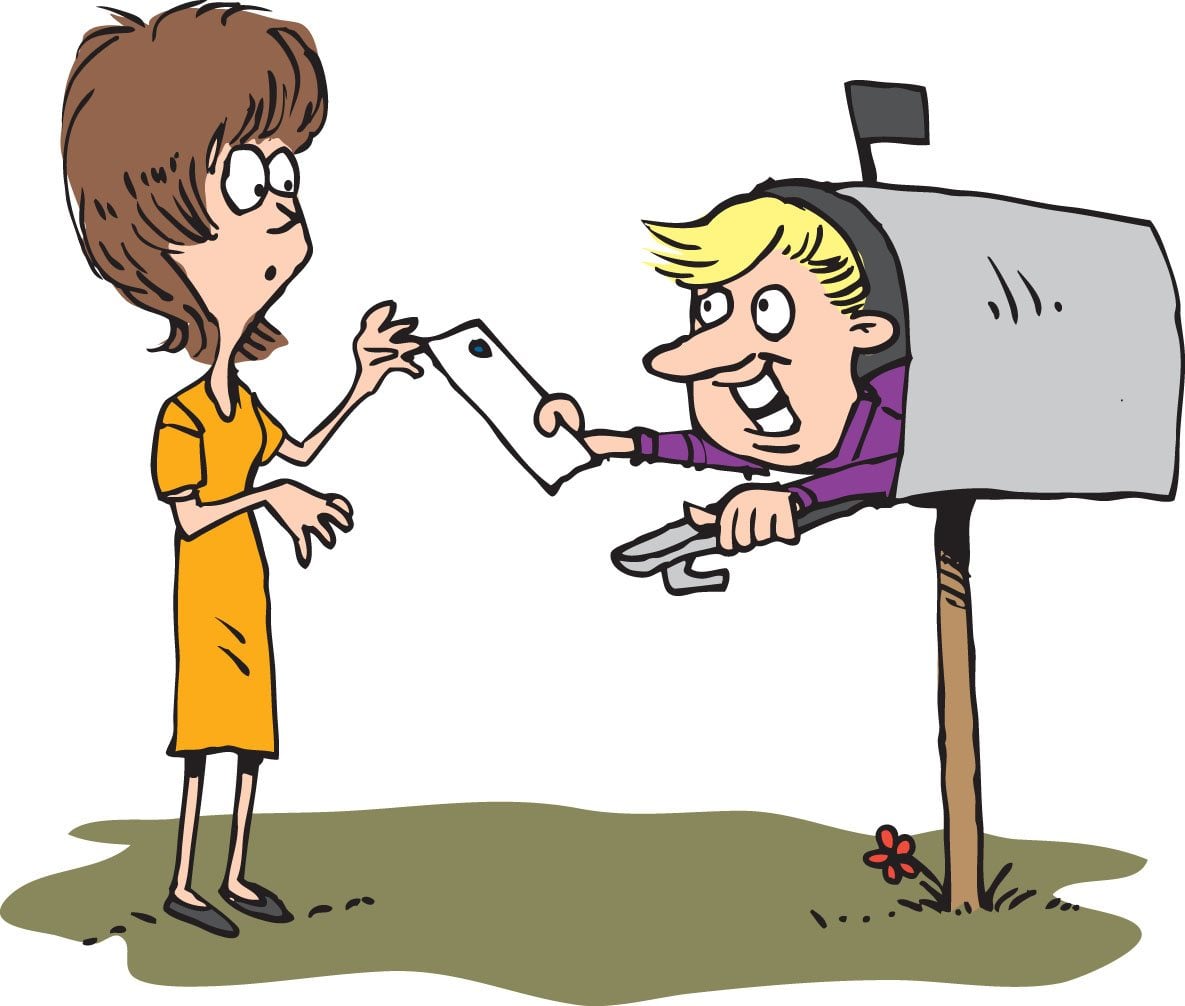“Direct mail marketing doesn’t work!!” “Direct mail marketing is expensive!”
Chances are that you’ve said or heard the above statements regarding direct mail marketing many times. But the fact is that direct mail marketing does work and can be an inexpensive way to gain new leads.
Why use Direct Mail Marketing? Direct mail marketing can be especially effective when you want to:
- Sell more to existing customers
- Reactivate non-active customers
- Reach all of your customers
- Generate new leads
Here’s an example. Let’s say that your business has a database of 3,000 customers. Of those, you have the email addresses of 2,000 of them and you email marketing offers to them on a regular basis. However, of the 2,000 customers that you are emailing, only 33% (or 600) customers open your emails. That means that you are missing out on selling to 2400 customers! That’s where direct mail marketing can be the most effective!
I asked business owners all over the United States to weigh in on direct mail marketing and the result is 17 Essential Elements of a Successful Direct Mail Marketing Campaign. I think you will find these tips helpful.
1. Goal: Generally there are two types of goals in direct mail marketing; to sell something right now; or to generate leads so you can sell something later. Your direct mail marketing copy should be written with your goal in mind.
2. Customer: Have a clear understanding of who the customer is that you want to attract and tailor all aspects of the direct mail piece toward them. Towne Park, a nationwide valet and parking management company, wanted to generate appointments general managers from 100 hotels that met Towne Park’s ideal customer criteria. Kathleen Booth, owner of Quintain Marketing in Annapolis, Maryland, whose company ran the direct mail marketing campaign for Towne Park says that they knew that they were trying to reach not only the busiest people in the hotel, but people with whom they had no prior relationship. They knew they had to do something different to get in front of their prospective customer so they implemented a multiple piece 3D direct mail campaign.
Booth explains, “The first mailer was a branded stopwatch that asked if the general manager knew how long his guests were waiting for the retrieval of their vehicle. Next, Towne Park sent a mailer asking if the GM was certain they are capturing all of their potential parking revenue and included a branded Magic 8 Ball.
The third week’s mailer focused on the Towne Park culture and their high level of customer satisfaction. Each GM received a map of the USA showing the cities Towne Park serviced and included a branded pitcher, custom designed canister and several packets of Kool-Aid with the message “See who is drinking the Towne Park Kool-Aid”).
After their prospects received the stopwatch mailer, Magic 8 Ball mailer and Kool-Aid mailer, they were sent a branded mailer tube with a white “surrender” flag asking for a meeting and promising this would be the last communication they received.”
The 3D mailer campaign had a remarkable 27 percent return on investment! Booth says, “Including a three dimensional object in the mailing was key to the success of this campaign. While typical direct mail has a very low response rate, dimensional mail tends to get opened (no one can resist opening a box!).”
3. List: Your customer database is a veritable goldmine and yet too many businesses fail to mine it! This database can be the starting point for hundreds, thousands, tens of thousands, even millions of dollars in sales because the people in your database already know you and trust you!
What if you don’t have a database? My first advice is to start building one! You can also purchase a database (or list). Lists can be selected based on a variety of criteria, such as zip code, marital status, etc. You may also be able to purchase a “responsive” mailing list, which is a list of people who have purchased products or services similar to yours in the past, therefore increasing the chances that they might purchase from you.
4. WIIFM (What’s in it for me?): According to Dan Kennedy, author of No BS Direct Marketing- Second Ed., “People are most easily and quickly interested in information that directly related to what interests them. Especially information that promises fascinating secrets, solutions to problems, protection from “dire threats” promises of seductive benefits or timely breaking news.”
Make sure your direct mail marketing piece clearly communicates what’s in it for them. And here’s a tip: Make sure that the WIIFM is what your prospects want!
5. Signature: This might sound like a no-brainer but it’s something that many direct mail marketers forget!According to Direct Mail Marketing Expert Doug Dickson, owner of Print Source One in Phoenix, Arizona, “When the reader examines a piece of direct mail, they are focused on answering two questions: 1) who is this from; and 2) what is it about? “
Dickson says, “Prospects will not immediately read every word, but scan their mail subconsciously, evaluating if it’s worth spending the time to read it. After reading the headline, the majority of prospects will immediately jump to the signature area. This makes the signature and P.S. areas another important area for marketing. Don’t underestimate their importance and use them to create additional interest and impact.”
A signature can be in the form of an actual signature with your business name, phone number, address and website URL, but it could also just be your business name and location information. Don’t forget to let people know who the direct mail piece is coming from.
6. Headline: Your headline can make or break the success of your direct mail piece. Dickson says, “It is absolutely critical to grab and keep your prospect’s attention. Because the headline is the very first thing your prospect will see, your first 15 words are more important than the next 500. Some advertising copywriters make a habit of writing a minimum of 50 possible headlines before seriously considering which one works best. Spend time considering which headline will grab the attention of your prospect.”
7. Message: The most successful message tells a story and appeals to the “what’s in it for me” nature. Your copy should tell a story that emotionally connects with your customers and clearly illustrates what the benefits will be to them if they heed your call to action. Write conversationally as if you were talking to a friend. And don’t be afraid to be bold in your claims; but just remember to back up your claims with examples. For example, if you claim that your prices are less than others use an image that illustrates such.
8. Offer: The offer is the bait that gets your prospects to do what you want them to do so you can reach your goal. Leila Banijamali, Founder and General Counsel of San Francisco based Startup Documents.com says “We mailed 300 perforated postcards with a free ticket to one of our monthly startup events, “Common Mistakes that Founders Make!” Approximately 40 startup founders showed up with mailer tickets in-hand at our event. This led to a larger networking pool and we were able to ask our founder customers, in person, about the intimate details of startup life and learn how else we might help them. Was well worth the cost of printing and postage.”
Typical offers include freebies such as “Free Admission” or discounts such as “Save 50%.” Just remember to do what Dan Kennedy advises and “Match Bait to Critter” and make it “an offer they can’t refuse.” The offer is all about what’s in it for them and has to be something that the prospective customer really wants.
9. Call to Action: The most successful direct mail marketing pieces give readers a clear call to action. Don’t assume you’re your prospect will do what you want. Tell them what you want them to do. For example, if you want them to call, say “Call Now!” or “Call me today.” Also give customers two or three different ways that they can easily respond. For example, they could call a phone number, email, or go to your website and fill out a form.
Also, make sure your call to action matches your customer. Jeff Giagnocavo, Co-Founder/Owner of Gardner’s Mattress & More in Lancaster, Pennsylvania, says “Our target market is boomers and seniors. Driving them to a Facebook page or QR code is silly (because this population doesn’t use this technology as much). We find call in, mail in, or stop in works best for this audience. Likewise for a younger audience these call to action mechanisms don’t work, Facebook and text work better.”
10. Sense of Urgency: You know how you suddenly accomplish more in a day just before you go on vacation, than you would any other day?The deadline of your upcoming vacation gives you a sense of urgency. I suggest that the thought of a looming deadline increases your adrenaline, giving you the push you need to accomplish more in less time.
You want to give the readers of your direct mail a sense of urgency so that they will be spurred to get off of their backsides and take action. There are many ways to instill a sense of urgency in your readers. You can do this by giving them a deadline to respond to your offer before it goes away. The trick on deadlines is to not make them too far out that people forget to respond or too close that they don’t have time to respond.
Another option is to indicate that there is a limited supply. The key here is that if the “limited supply number” is too low, the customer won’t even try to respond because they don’t think they will have a chance.
11. Personalization: Personalization can have a dramatic impact on your direct mail marketing campaign. Because the one thing that people are most interested in is themselves, many will respond favorably when they see their name all over the mailing piece. However, personalization can backfire if you spell their name wrong. Personalization is especially effective when marketing to your own customer database.
12. Credibility: If you’re mailing to a mailing list of cold prospects you should include some credibility elements on your direct mail piece to help make your prospects trust you. Credibility elements vary based on what you want to sell and the trust factor involved in getting customers to buy from you. For example if you sell high risk products or services (usually high dollar amounts such as cars, financial services, etc.), adding testimonials from happy customers can help your prospects feel good about responding to your offer.
If you sell low risk products and services (usually low dollar amounts such as food, clothing, etc.) then beautiful, clear photos of the product or service can build credibility. You could also use credibility builders such as awards you have won, associations you are members of, case studies, or press you have received.
13. Dare to be Different: Don’t be afraid to do direct mail marketing differently than your competitors. Jon Toy, owner of Fastsigns in York, Pennsylvania, says “Be sure to show up differently and put your own personality into it.” Toy mailed a handwritten letter and greeting card to his top 200 customers. The greeting card which was written in crayon was a message from his new baby son asking people to buy printing so that his daddy could stay home for a period of time and help mommy take care of him. The goal of his mailer was to increase sales and keep his team busy while he was out of the office. The mailer included a “Baby Deal” or a percentage off your order based on the day the baby was born. According to Toy the mailer resulted in a 13% return on investment.
Ben Landers, President of Blue Corona, an inbound marketing firm based in Gaithersburg, Maryland, has a similar “Dare to Be Different” story. Landers says, “When we first launched our business, we did a direct mail campaign that generated an incredible return. Against the advice of our printer, we sent a 30 page (yes, 30 page), bound collection of case studies to approximately 400 business owners. Between inbound responses (calls and emails) and outbound follow ups, we closed roughly 20 sales. Those 20 sales have generated more than $400,000 in revenue–not too shabby given the $10,000 or so we invested in the campaign.”
14. Timing: According to marketing expert Mike Capuzzi, author of High Impact Marketing Manifesto, “Timing is a funny thing. On one hand it can be an almost exact science and on the other, luck has a huge part to play in it.” Timing is critical to the success of your direct mail marketing campaign. You want to mail your piece when your prospects will most likely respond.
15. Postage: Direct mail expert Doug Dickson says “Postage is the most costly element of any direct mail campaign. Most campaigns can benefit by being mailed as standard mail, saving about .10¢ over the first-class rate. If you are mailing prospects in a specific area around your business, you might consider the US Post Office’s EDDM (Every Door Direct Mail) program. This rate reduces postage to as low as .174¢ per piece and eliminates the cost of a mailing list, but requires that you mail to everyone within the carrier route.”
16. Tracking: Another important element of a successful direct mail campaign is tracking. After all, how will you know how successful your campaign is if you don’t track it? Don’t rely on manual tracking systems run by your employees because almost without fail, your employees are going to mess it up. Instead, automate your direct mail marketing tracking using a call tracking phone number.
A call tracking phone number can be purchased from a variety of vendors such as LogMyCalls.com or IfByPhone.com for as little as $50 a month. Use a call tracking system that records the phone calls as well as reports number of calls so that you can tell how well your employees are selling or setting appointments. Use separate landing pages on your website that are in alignment with your direct mail piece’s message. You’ve got to track your results.
17. Follow up: Follow up can greatly increase the conversion rates of your direct mail campaign and can be done in a variety of ways. In Towne Park’s example above they followed up the first direct mail piece with several more direct mail pieces. Other ways of following up include phone calls, emails, and in person visits. Again, it all depends on who your customer is and the best way to reach them.
Conclusion:
Direct mail marketing can be a very profitable marketing tactic when done correctly. However, there’s one thing to keep in mind. Dickson says, you need to “have a long term perspective. Direct mail should not be viewed as a “one and done” project; instead, it should be created as a campaign. Prospects need to hear the message not once, not twice, but several times (up to six even) before they buy. Be patient and give your prospects time to understand and accept your offer.”
Wendy Kenney owns 23 Kazoos, a marketing and PR firm that specializes in small business, agriculture, and auto repair shop marketing. She is the best-selling author of “How to Build Buzz for Your Biz” and has been quoted in USA Today, Newsday, and The New York Times. Click to download a free “Direct Mail Marketing Special Report” version of this article including samples of the direct mail marketing pieces mentioned.





